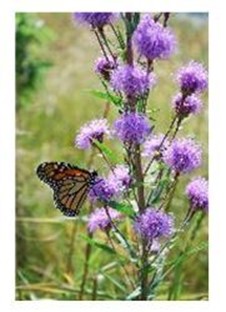What's Working for Conservation
State Native Vegetation Recommendations
2025 Information
2023 Legislation directed BWSR to work with a wide range of partners to increase collaboration about the use of native

vegetation and establishing biodiversity across landscapes. Key discussion topics have included appropriate seed and plant source distances for projects, climate considerations for vegetation, appropriate plant species for programs, and the status of state resources about vegetation establishment, enhancement and management. The discussions have been used to develop guiding principles and recommendations that have are included in a report on a new webpage. The project is also guiding the continued evolution of BWSR’s Native Vegetation Establishment and Enhancement Guidelines and other state technical resources that are used for many programs. The following are key recommendations from the report:
Build capacity to address ecological ecosystem threats: There is an urgent need for habitat protection and management to address climate change and habitat loss. Advisory team members are committed to pursuing funding sources for longterm management of native plant communities, as well as staffing to aid Tribal Nations, soil and water conservation districts, watershed districts and other local partners’ protection and restoration efforts.
Build and maintain biodiversity across landscapes: Efforts are needed to establish prairies, manage forests, restore wetlands and establish habitat on solar sites, along roadsides and in utility corridors. We need to find innovative ways to incorporate biodiversity across landscapes. Fortunately, residents across Minnesota are motivated to be a part of the solution by supporting large-scale restoration and biodiversity efforts. One example: Minnesota residents have installed over 10,000 pollinator plantings in recent years through BWSR’s Lawns to Legumes Program.
Make landscape connections: Connected landscapes build resiliency and provide refuge for pollinators and other atrisk species. Managing intact natural habitats is an important piece of landscape preservation since these habitats are essential for wildlife populations. However, we also need to establish new habitat corridors across landscapes, which can help mitigate the effects of climate change.
Restore multiple landscape benefits: Projects need to rebuild ecological function and restore multiple landscape benefits such as clean water, flood retention, wildlife habitat, climate adaptation and mitigation, in addition to economic benefits. Many working lands approaches such as haying and grazing support productive land uses that are compatible with restoration and protection goals. Linking ecosystem restoration efforts with watershed-scale planning and protection will also play an important role in promoting landscape restorations that maximize multiple landscape benefits, support local economies and improve water quality.
Increase seed and plant production and collection: There is a need for conservation professionals to identify opportunities to collect seed of species unavailable or in short supply at native plant nurseries. Increased seed collection and seedling production from more diverse genetic sources from Minnesota and adjoining states is needed to help ensure the resiliency of plantings as the climate changes.
Continue discussions about appropriate seed and plant sources: Further guidance is needed about from how far away seed should be gathered to ensure that plants will be resilient to Minnesota winters, and to prevent the introduction of invasive species from other geographic areas. Technical teams should assist migration efforts using available state, federal, and Tribal resources as guidance.
Build relationships with Tribal communities: Tribal communities have valuable knowledge about how their ancestors managed their lands for thousands of years. Climate change is affecting plants and ecosystems that the Ojibwe, Dakota and other Indigenous peoples have relied on for centuries. Historically, Tribes have used native species — such as wild rice, blueberries, ostrich fern, and hazelnut — for subsistence. Plants such as sweetgrass, prairie sage and white cedar were used in ceremonies and for medicine, while black ash and cattail were used to make baskets and other practical items. The advisory team acknowledges that it needs to treat this knowledge as a gift and that it must build respectful relationships with Tribal communities before requesting expertise and knowledge. We believe these relationships can provide a deeper understanding and appreciation for traditional land-based practices that may be incorporated into contemporary land management.
Restore key landscape processes: We need to build capacity to restore and mimic key landscape processes such as prescribed burning and conservation grazing, which are critical to the ecological integrity of many plant communities. This will require increased capacity to conduct prescribed burns and provide infrastructure for grazing. To accomplish this, more training is needed for professionals who conduct prescribed burns. Invasive species will continue to increase as they are effective at dispersal, giving them an advantage in adapting to climate change. We will need to combine practices such as water level management, prescribed burning, prescribed grazing, mowing and haying to replicate natural disturbances and promote diversity, function and resiliency.
Pursue innovative restoration and rewilding strategies: We need to be innovative as we continue to improve landscape restoration and management practices. That might include using temporary covers to rebuild soil health, supplemental seeding to increase plant diversity and cover mixes to suppress invasive shrub seedlings. It might involve extended site preparation time, adding more cool-season grasses to suppress weeds, enhancing soil microorganisms, adopting culturally focused burning practices, cooperative prescribed burning, using non-herbicide site preparation methods, and haying and grazing to reduce nitrogen in ecosystems. New information will be needed about bioengineering practices, urban development on poor soils, rewilding highly disturbed landscapes, utility corridor enhancement to complement BWSR’s Habitat Friendly Utilities Program, peatland restoration methods, diverse woodlands management, and managing volunteers.
Expand outreach and equity efforts: Further education and outreach is needed about how Minnesotans can play a role in establishing and managing resilient native plant communities. For example, Minnesotans could plant native gardens; restore prairies, forests, savannas and wetlands; and support conservation organizations. Educating young people through outreach and habitat projects at schools will be essential, as they are the next generation who will carry on this important work to preserve and enhance native landscapes across Minnesota. (Dan Shaw, BWSR)
